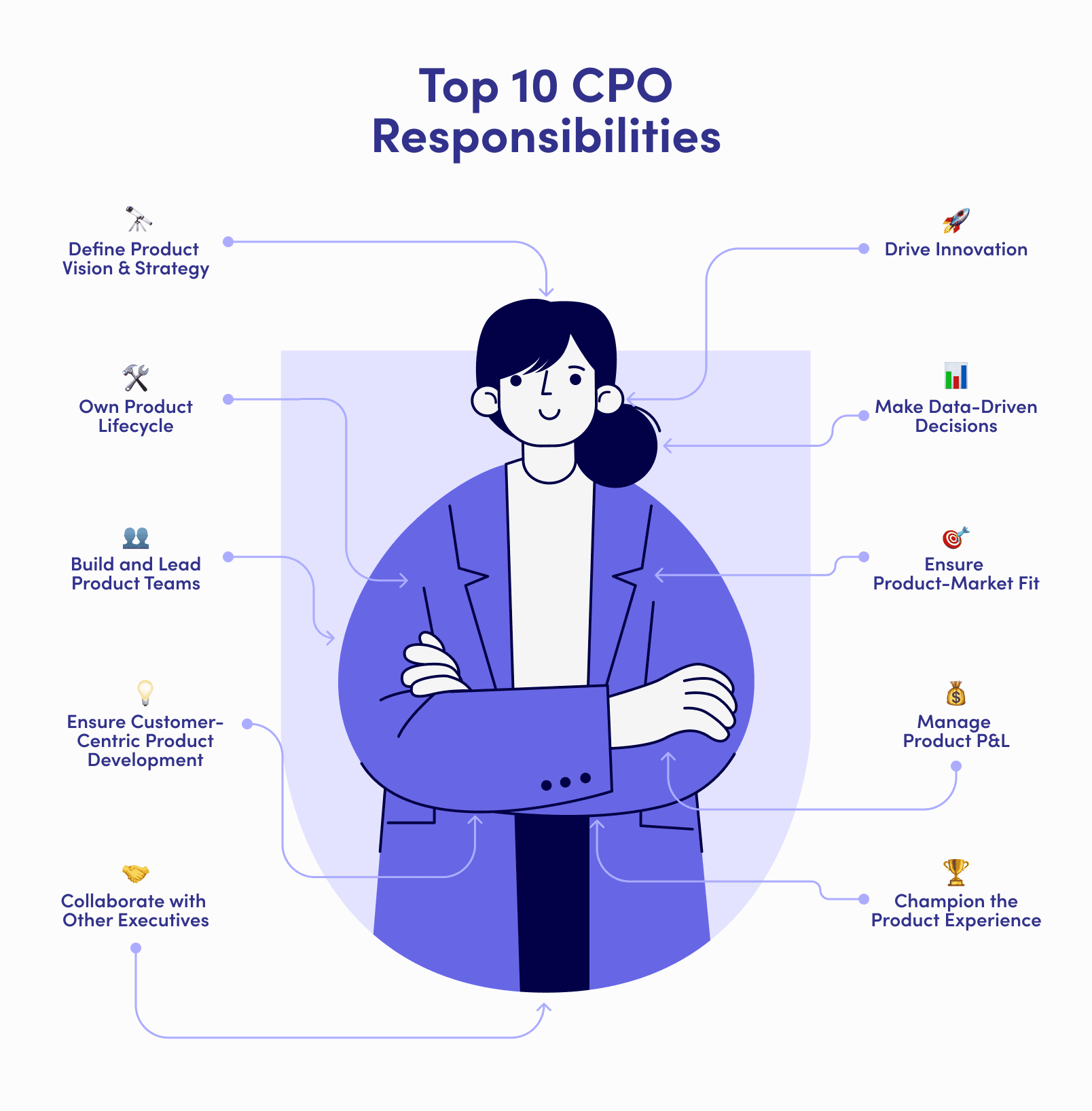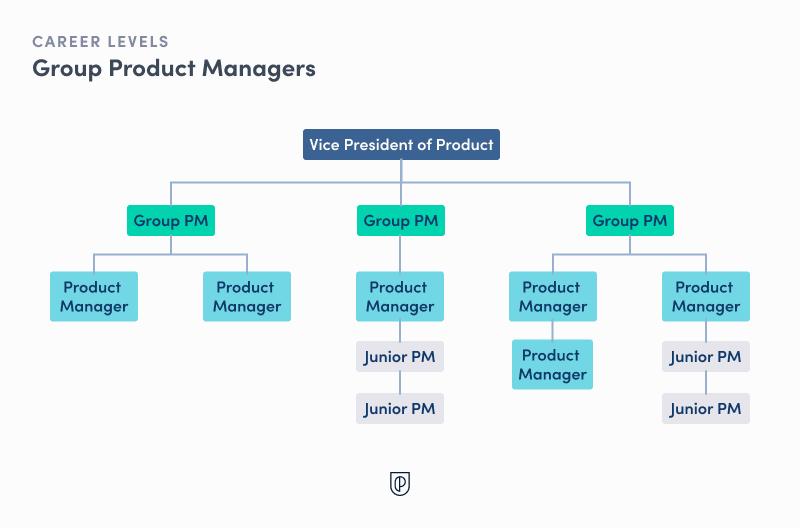Updated: November 6, 2024- 16 min read
CEOs, CTOs, and CFOs are taking all the spotlight in contemporary media, and deservedly so. They carry immense responsibility to steer companies towards a thriving future.
But there’s one role that’s been quietly shaping our everyday life without much fanfare: the Chief Product Officer (CPO).
It’s the CPOs who are transforming half-baked ideas into the products you can’t live without. They’re not just making decisions; they’re making tangible things you use daily. This role is about more than just steering a ship; it’s about making bold decisions that drive the entire product forward.
If you think a CPO is just another executive role, think again. In this guide, we’ll unpack what makes a CPO essential and how they’re shaping the future of business.
Product OKR Template
Use this Product OKR template to set and track your OKRs (Objectives and Key Results). Align your team’s daily tasks with product and company strategy!
get free template
What Is a Chief Product Officer (CPO)?
The Chief Product Officer (CPO) is the person responsible for overseeing a company's entire product strategy, from Product vision to execution. In simple terms, they ensure that the products a business creates align with customer needs and the company's goals. But the role is much more than that—it's about driving innovation, shaping product experiences, and making strategic product decisions that impact the company's growth.
The CPO role didn’t always exist. Historically, Product Management was a fragmented responsibility shared between marketing, engineering, and design teams. But as companies started building more complex, customer-focused products, they needed a clear leader to manage the entire product lifecycle.
Enter the CPO. This role became formalized with the rise of Agile, Lean, Design Thinking, and other Product Management frameworks — processes that emphasize collaboration, rapid iteration, and customer-centricity.

Today, the CPO is crucial for product-driven companies. Next to other executive product positions like Group PM, Director of PM, and Principal PM, they ensure that every product decision aligns with long-term strategy and market demand. They’re the bridge between vision and reality, bringing products to life in a way that not only serves customers but also drives business success.
Product Strategy Template
The higher you go up on the Product career ladder, the more strategic skills matter. This template helps you define the why and how of product development and launch, allowing you to make better decisions for your users, team, and company.
Download Template
Roles and Responsibilities: What Does a Chief Product Officer Do?

You can no longer just lead people. You have to know the craft to pull up your sleeves, get in there, and solve it yourself. Because a couple of things happen when you do that yourself. One, you're staying close to the craft and the craft is changing every day. The second is — you will win people’s trust because they believe you know what the real problems are.
—Prashanthi Ravanavarapu, Global Fintech Product Executive at PayPal, on The Product Podcast
The Chief Product Officer (CPO) wears many hats, but their main mission is to align product development with business strategy. This role isn’t just about managing the product team; it’s about steering the entire product vision, strategy, and execution at the highest level.
Let’s break down the nitty-gritty of what a CPO job description usually entails.
1. Defining Product Vision and Strategy
At the core of a CPO’s role is setting the long-term vision for a company’s product. This means understanding where the market is going, how customer needs are evolving, and ensuring the product roadmap is built to meet those demands. The CPO works with cross-functional teams—marketing, sales, engineering, and design—to craft a cohesive product strategy that drives both customer satisfaction and company growth.
The CPO must be able to ask the right questions: Where is this product headed in five years? How does it align with the company’s goals? They connect the dots between what customers want, what the company needs, and what the product should become.
2. Ownership of Product Lifecycle
From the birth of an idea to the product launch plan (and beyond), the CPO owns the entire product lifecycle. They make sure that every stage—from ideation to development, release, and iteration—is running smoothly and efficiently. This involves working closely with Product Managers to oversee the progress, identify potential roadblocks, and ensure everything stays on course.
A critical part of this responsibility is making tough decisions and using frameworks for product prioritization. The CPO must be able to assess market feedback, competitor moves, and product data to decide how to position a product, what features or improvements to push, what to delay, and what to scrap entirely off of the product portfolio.
3. Building and Leading Product Teams
While Product Managers manage specific product lines or areas, the CPO oversees the entire product organization. That means recruiting, training, mentoring, and leading the product team. They ensure every team member — from junior Product Manager to director of product — is aligned with the broader vision and is empowered to execute their responsibilities effectively.
The CPO also creates a culture of innovation and collaboration. In many ways, they are the glue that keeps cross-functional teams working together seamlessly. This includes ensuring the product team is in sync with engineering, design, marketing, and sales, so everyone is aligned on the product’s direction and objectives.
4. Customer-Centric Product Development
One of the most critical aspects of a CPO’s job is to ensure that products are customer-driven. The CPO needs to have a deep understanding of the customer’s needs, pain points, and behaviors. This means overseeing customer and user research, gathering feedback, and using insights to guide product development.
In Agile and Lean environments, the CPO often plays a key role in driving continuous iteration based on real-time data and customer feedback. They push for rapid prototyping, frequent testing, and fast pivots when necessary to keep the product mix relevant and competitive in the market.
5. Collaboration with Other Executives
The CPO isn’t just working with the product team — they are a key member of the executive leadership team. The CPO collaborates closely with the CEO, CFO, CMO, and CTO to ensure the product strategy aligns with broader business goals. For example, they work with the CTO on technical feasibility, the CMO on product positioning, and the CFO on budgeting and pricing for product initiatives.
This cross-functional collaboration is essential because it ensures that product development is not happening in a silo. Every decision the CPO makes impacts other areas of the business, and their ability to communicate and coordinate with other executives is vital to driving the company forward.
6. Driving Innovation
Innovation is the lifeblood of product development, and the CPO is the person responsible for pushing the envelope. Whether it’s adopting new technologies, testing out bold product ideas, or exploring untapped markets, the CPO keeps the company ahead of the curve.
This requires not just creativity, but also the ability to spot trends and shifts in the market before they become mainstream. The CPO has to be constantly thinking ahead. They have to look for opportunities to disrupt the market and ensure that the company’s product offerings remain competitive.
7. Data-Driven Decision Making
In today’s data-centric world, a CPO must be highly analytical. They don’t just rely on intuition or market trends; they make decisions based on hard data. This includes product usage metrics, customer feedback, A/B testing results, cost of delay, and financial analysis. The CPO must interpret this data to identify what's working, what’s not, and where to invest next.
Data is also critical when it comes to measuring the success of product initiatives. The CPO sets key performance indicators (KPIs) and objectives and key results (OKRs) to track progress and ensure the product is moving in the right direction.
8. Ensuring Product-Market Fit
Arguably one of the most important responsibilities of a CPO is ensuring product-market fit. The product must not only meet customer needs but also solve real problems, meet lucrative USPs, and offer a better experience than competitors in those defined, high-reward areas.
The CPO continuously refines and evolves the product offering to stay aligned with market demands and to capitalize on new opportunities.
9. Managing Product P&L
While Product Managers often deal with execution and team management, the CPO is responsible for the financial side of product development.
They oversee the product's profit and loss (P&L) and ensure the product’s budget aligns with business objectives. This means making tough calls about resource allocation, pricing strategies, and balancing investment in innovation with the need for profitability.
10. Championing the Product Experience
At the end of the day, the CPO is the advocate for the product within the executive team. They ensure that the product not only meets the business's strategic goals but also delivers exceptional value to the users.
They focus on creating products that people love to use. This often involves putting themselves in the customer’s shoes to ensure a seamless, intuitive experience across all the product channels.
A great example of a CPO who is also a Product Champion is Fernando Fanton, CPO at Monzo, seen here talking up Monzo's Product Experience at ProductCon London:
Qualifications Needed for the Position of CPO
When companies are looking to hire or promote a Chief Product Officer (CPO), they prioritize a combination of experience, leadership, and strategic thinking. Here are the key qualifications typically required:
Extensive Product Management Experience
Over 8-10 years of hands-on Product Management experience, including leading teams, crafting product strategies, and managing the product lifecycle from concept to launch.Proven Leadership Skills
Demonstrated success in leading cross-functional teams (engineering, design, marketing), mentoring Product Managers, and scaling product organizations.Strategic Vision and Business Acumen
Ability to align product strategies with broader business goals, with a focus on driving revenue growth and innovation.Customer-Centric Mindset
Strong track record of creating products that address real customer problems, using methodologies like Design Thinking or Lean principles.Experience with Agile or Lean Methodologies
Expertise in iterative development, rapid prototyping, and data-driven decision-making, common in today’s fast-paced product environments.Excellent Communication and Stakeholder Management
Ability to clearly articulate product vision to internal teams and external stakeholders, ensuring alignment and support across the board.Technical Background
Preferred in tech-driven industries, this helps the CPO collaborate effectively with engineering teams and understand technical constraints.Proven Track Record of Product Innovation
A portfolio of successful product launches and innovations that have significantly impacted market share or business growth.
Most Sought-after Skills for CPO Role
After analyzing over a dozen open Chief Product Officer job postings on LinkedIn, we've identified the most commonly required skills for this role. Here's what companies are consistently looking for:
Product Mastery: Extensive experience in Product Management with a deep understanding of the entire product lifecycle, from ideation to market success. You should be as familiar with a product roadmap as a conductor is with a baton.
Strategic Vision: Ability to see the big picture and align product strategies with business goals. You’re a leader who can forecast market trends and adjust the product portfolio accordingly.
Customer Empathy: A keen understanding of customer needs and the ability to translate those needs into successful products. You’re always the customer’s advocate, ensuring their best interests are front and center.
Analytical Mindset: Strong ability to interpret data and leverage it to drive product decisions. You can dig into user data and market trends to make informed, impactful choices.
Leadership Prowess: Proven experience leading and scaling product teams with a history of delivering innovative products. You can inspire and guide teams to success.
Solid Technical Expertise: For roles in the IT sector, extensive experience in R&D and technology Product Management is essential.
Regulatory Knowledge: A strong understanding of regulatory requirements for a specific niche where products are offered, with the ability to navigate complex regulatory landscapes.
Project & Change Management: Strong skills in managing multiple projects, meeting tight deadlines, and executing strategic initiatives with precision.
Influencing & Negotiation: Skilled in building relationships across all levels of the organization, using a tactful approach to drive accountability.
Self-Motivation & Proactivity: A proactive mindset with a talent for identifying and addressing issues before they become problems.
How Much Does a Chief Product Officer (CPO) Make?
As of the time of writing, the average annual salary for a Chief Product Officer (CPO) in the United States is $293,180.
Of course, this can vary based on experience, industry, and location. According to Salary.com, most CPOs earn between $263,480 and $327,480 per year, but salaries can go as high as ≈$358,000 or dip to around $236,000 at the lower end.
To break it down, the average monthly salary for a CPO is about $24,400.
Where you work, and the industry you’re in can significantly affect what you make. CPOs in tech-heavy industries, like software or biotech, often command higher salaries than those in more traditional sectors. Additionally, location matters — CPOs in states like California and New York tend to earn more than those in smaller markets due to higher demand and cost of living.
On top of base salary, many CPOs also receive performance-based bonuses, equity packages, and other perks that can substantially boost their total compensation. So, if you have your eye on the CPO role, keep in mind that the paycheck can be as fluid as the role itself.
Chief Product Officer in an Organizational Chart

When it comes to product leadership, the Chief Product Officer (CPO) is at the top of the hierarchy as you see in the organizational chart. But there are other roles that play key parts in managing and driving the product function within a company. Let’s break down how the CPO compares to these roles:
CPO vs. Senior Vice President (SVP) of Product
The CPO and SVP of the Product are very close in the hierarchy. The difference often comes down to scope. While both are responsible for product strategy, the CPO usually has a broader, more executive-level focus.
They are part of the C-suite. This means they influence the company’s overall direction along with other executives on the same vertical. The SVP of Product, on the other hand, may focus more on execution, ensuring that the product strategy defined by the CPO is successfully implemented.
CPO vs. Head of Product or VP of Product
The VP or Head of Product is typically one level below the CPO. While the CPO oversees the entire product organization and ensures product strategy aligns with the company's goals, the VP or Head of Product focuses more on day-to-day operations.
They are responsible for implementing the CPO’s vision, managing product teams, and making sure development stays on track. They often have a narrower scope. They focus on specific product lines or areas of the business, whereas the CPO has a company-wide view.
CPO vs. Principal Product Manager
A Principal Product Manager is a highly experienced individual contributor. Unlike the CPO, who focuses on strategy and leadership at the highest level, a Principal Product Manager works on specific product initiatives, often leading major projects or high-stakes product features.
While they have significant autonomy and expertise, they don't manage the entire product organization like a CPO does. Instead, they’re deep in the product development process, making tactical decisions that affect a particular part of the product.
CPO vs. Director of Product Management
The Director of Product Management manages a team of Product Managers and is responsible for multiple product lines or initiatives. While they have a leadership role, they are more focused on the tactical side of Product Management, ensuring the day-to-day work of product teams aligns with the company’s goals.
The CPO, by contrast, has a much broader role that includes setting long-term strategy, making high-level product decisions, and working with other executives to drive company-wide growth.
CPO vs. Group Product Manager (GPM)

A Group Product Manager leads a group of Product Managers and focuses on a particular product group or segment. The role is similar to the Director of Product Management but often a bit more hands-on.
The GPM ensures that the Product Managers they oversee are executing that vision within their specific area. The GPM is closer to the day-to-day product development, and are often Senior Product Managers on their path to executive functions.
Does every organization need a CPO?
Not every organization needs a Chief Product Officer (CPO). Still, depending on company’s size, complexity, and product focus, many would benefit from one.
For example, the founders often serve as the product visionaries (1) in small startups. At that stage, it’s more about speed and agility, and the team may not have enough complexity to justify a dedicated CPO. However, as companies grow and their product portfolios expand, the need for a clear, centralized product strategy starts to creep in.
(2) Medium-sized businesses are where things get interesting. These companies often reach a point where product teams are scaling, and leadership needs to focus on long-term strategy. A CPO can bring that strategic oversight. They make sure the right products are being developed for the right markets, at the right time. Without that, product teams can become siloed, or you risk misalignment with the company’s larger vision.
In (3) enterprise organizations, a CPO is almost a given. The complexity of managing multiple product lines, coordinating cross-functional teams, and driving innovation requires someone at the top. Without a CPO, it’s easy for product priorities to get lost or muddled.
When companies begin introducing new products to their portfolio, the complexity increases exponentially regardless of their current size. It’s not just about managing people anymore—it's about managing multiple product lines, each with its own data, customer base, and market dynamics.
In addition to people management, you're juggling a wealth of data—product performance metrics, customer feedback, market trends—and making decisions based on all of it. Without a CPO, it’s easy for teams to focus too much on their own product areas, leading to misalignment across the organization. A CPO keeps everything connected, so the company can grow its portfolio without losing sight of its core goals.
In our experience, the real question isn’t if every organization need a CPO — it's "At what stage does having a CPO become essential?" For many growing businesses, that point comes sooner than they might realize.
How to Become a Chief Product Manager
Becoming a Chief Product Officer (CPO) typically requires a mix of experience, leadership skills, and a deep understanding of Product Management. For most, the journey starts by working as a Product Manager and gradually taking on more responsibilities within product teams.
To rise to the CPO level, it's common for Product Managers to first move into product leadership roles, like Product Lead or Senior Product Manager, before transitioning to a VP of Product for instance.
Along the way, spending years in Product Management and developing strong leadership skills is key. Many successful CPOs also broaden their knowledge by seeking out leadership training and advanced certifications. If you're looking to make that leap, investing in your personal growth, such as through our in-house Product Leader Certification, can give you the insights and leadership tools needed to stand out.
Remember, it's not just about mastering the product; it's about learning how to lead teams, make strategic decisions, and understand how things operate on a higher level. Continuing to expand your skills and experience, especially in leadership, is what will ultimately push you into a CPO role.
Discover the World's Largest Product Management Community
Join Product School's private Slack community and network with over 100,000 PMs.
Join Now
Updated: November 6, 2024




